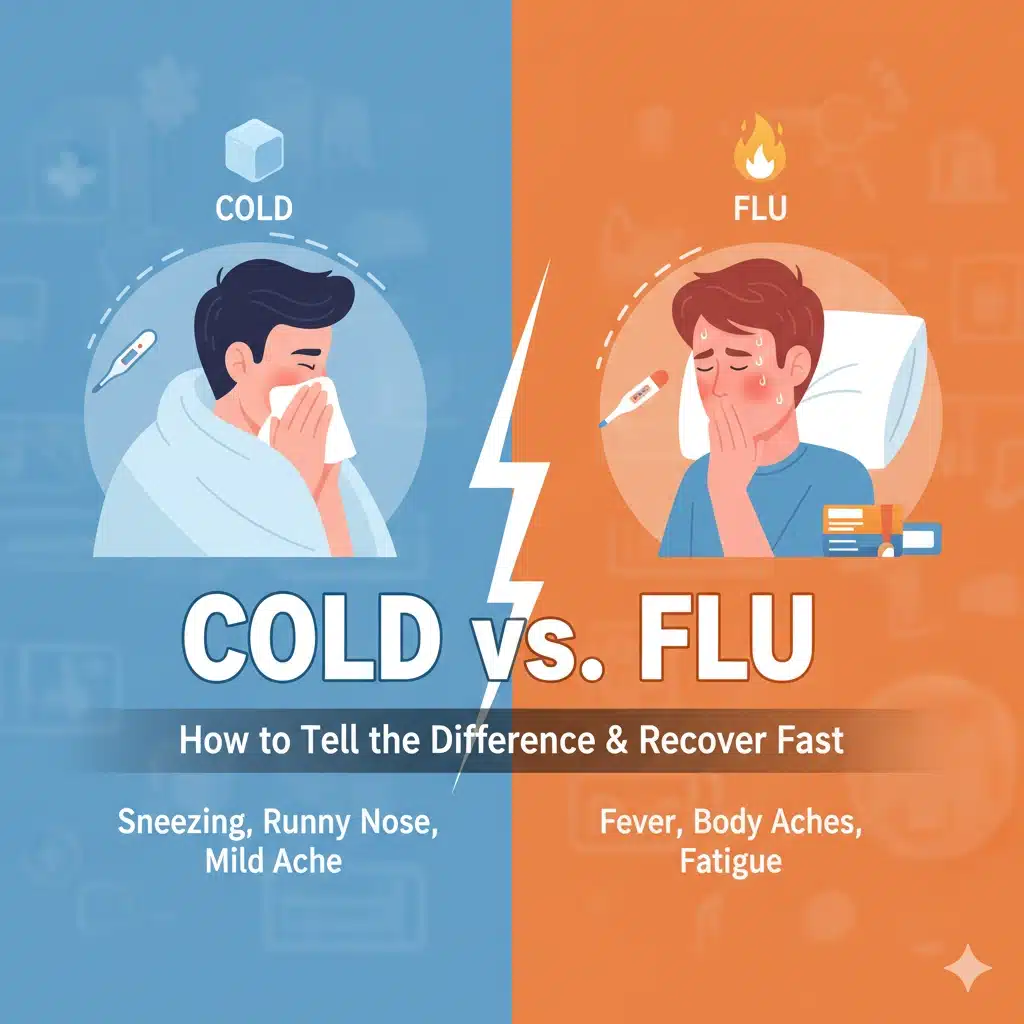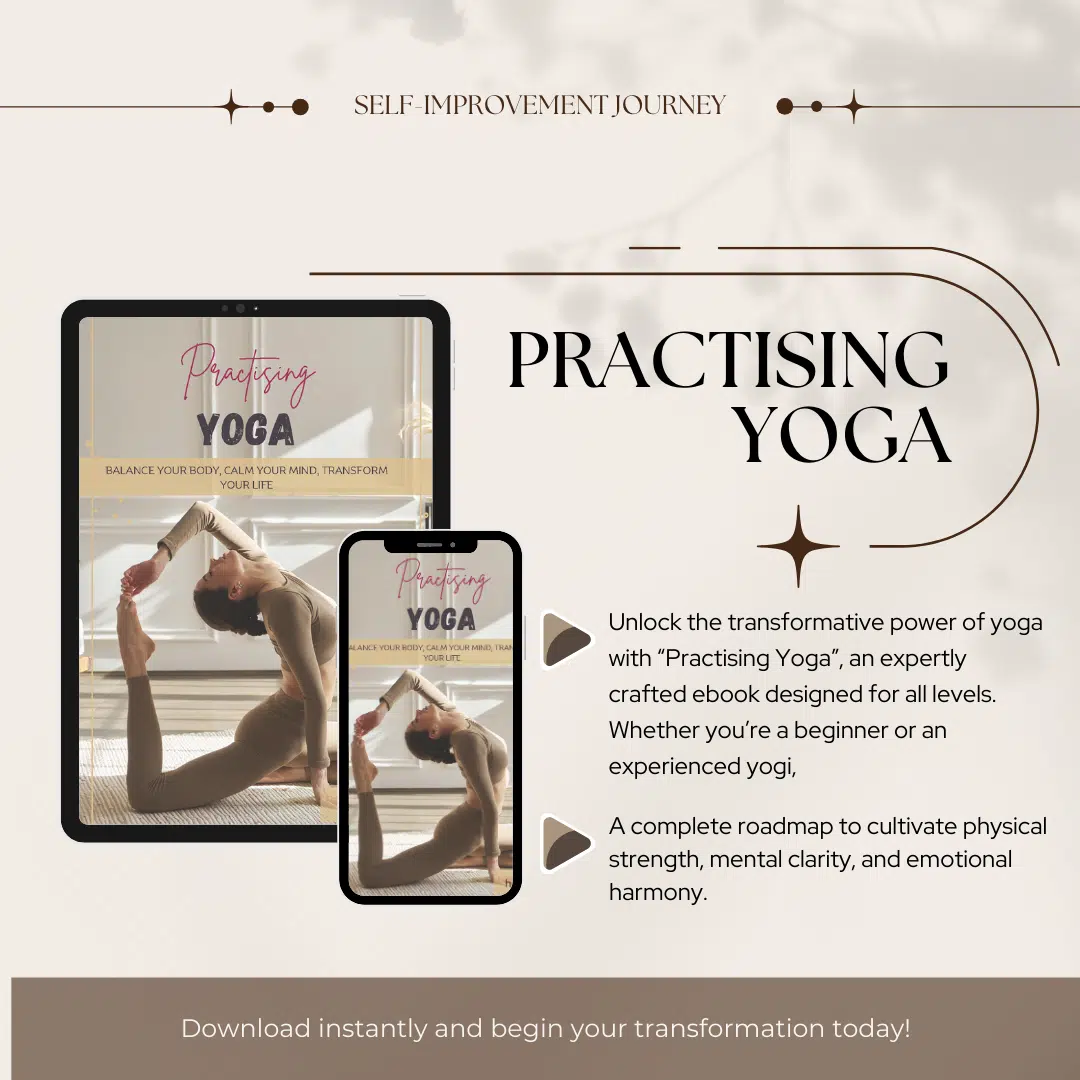That all-too-familiar feeling is setting in: a tickle in your throat, a wave of fatigue, and the looming question—is this just a common cold, or have I been hit by the flu? In a world of well-meaning but often contradictory advice, knowing the answer is more than just trivia; it’s the key to getting the right care, recovering faster, and protecting those around you.
We believe that understanding your body is the first step toward true wellness. This guide cuts through the confusion about Cold vs. Flu, offering you a clear, actionable roadmap. We’ll empower you with a precise symptom checker, explain the science behind your symptoms in simple terms, and provide a practical, step-by-step plan to help your body heal, whether you’re facing a common cold or the more formidable flu.
Why It’s Crucial to Know the Difference
It’s easy to dismiss that initial sniffle as “just a bug,” but recognizing whether it’s a cold or the flu is a critical act of self-care. This isn’t about labeling your misery; it’s about choosing the most effective path to recovery and avoiding potentially serious complications.
More Than Just a Bad Cold
While both are respiratory illnesses, they are caused by completely different viruses. Think of it this way: a cold is like a minor, annoying software glitch on your phone—it’s frustrating but usually doesn’t cause lasting harm. The flu (influenza), however, is a serious virus that can crash your entire system. The flu can lead to severe complications like pneumonia, bronchitis, and hospitalizations, particularly for the young, elderly, and those with chronic health conditions. The CDC estimates that influenza has resulted in 9 million – 41 million illnesses and hundreds of thousands of hospitalizations in the U.S. annually. Understanding this risk from the outset changes how you respond.
The Right Response for the Right Illness
Identifying your illness correctly allows for targeted action. If it’s the flu, seeking medical attention early can open the door to antiviral medications that can shorten the illness’s duration and severity. If it’s a cold, you can focus your energy on comfort and symptom management without unnecessary medical interventions. This knowledge saves you time, money, and, most importantly, helps you get better faster.
The Cold vs. Flu Symptom Checker: A Side-by-Side Guide
Use this detailed breakdown as your at-home diagnostic tool. Remember, symptoms exist on a spectrum, but this guide highlights the most common distinctions. For the official medical perspective, you can always refer to the CDC’s detailed cold and flu comparison.

Symptom Onset and Severity
- Cold: Symptoms are polite, albeit unwelcome, guests. They arrive gradually. You might feel a little off one day, develop a scratchy throat the next, and then wake up with full-blown congestion on day three.
- Flu: The flu is an intruder that kicks the door down. It hits you abruptly and with force. It’s common for people to say they felt fine at lunch but were completely debilitated by dinnertime.
Fever, Aches, and Fatigue
- Cold:
- Fever: Rare in adults, though a slight fever is possible in children.
- Body Aches: If they occur, they are typically mild and manageable.
- Fatigue & Weakness: You’ll feel tired and run down, but you can likely still function and get through your day (though you shouldn’t).
- Flu:
- Fever: A high fever (100°F to 102°F, and even higher in children) is very common and often a defining feature.
- Body Aches: These are often severe. Your muscles and joints may feel like you’ve been through an intense workout you never did.
- Fatigue & Weakness: This is profound and debilitating. The fatigue can be so extreme that getting out of bed feels impossible. This can last for several days, even after other symptoms improve.
Respiratory Symptoms: Cough, Sore Throat, and Congestion
- Cold: Symptoms are predominantly “above the neck.” You’re likely to experience:
- A stuffy or runny nose (often with clear mucus that may thicken and turn yellow or green).
- Frequent sneezing.
- A sore, scratchy throat.
- A hacking, mucus-producing (chesty) cough.
- Flu:
- A dry, persistent cough is a hallmark symptom. It can be severe and linger long after other symptoms have resolved.
- A sore throat and congestion can occur, but they are not always the main event. The flu is more of a full-body assault.
Your Action Plan for Faster Cold Recovery
Since a cold is a self-limiting virus, the goal isn’t to “cure” it but to create the optimal environment for your immune system to do its job efficiently. Your mantra should be: Support, don’t fight.
Support Your Body, Don’t Fight It
Your body is using a massive amount of energy to battle the virus. The kindest thing you can do is give it that energy back.
- Rest: This is non-negotiable. Cancel non-essential plans, work from home if possible, and allow yourself to sleep and rest. Pushing through only prolongs the illness.
- Hydration: Water, herbal teas, broth, and electrolyte drinks are your best friends. They help thin mucus, keep your mucous membranes moist, and flush out toxins. A warm cup of The Best Herbal Teas for Cold Season can be incredibly soothing for both your throat and your spirit.
Smart Symptom Management
Target your discomfort with specific, effective remedies:
- For Congestion: A saline nasal spray or a neti pot can flush out mucus and allergens without the rebound effect of medicated sprays.
- For a Sore Throat: Gargle with warm salt water, suck on zinc lozenges (if started within 24-48 hours of symptoms), or use soothing honey-based lozenges.
- For General Discomfort: A humidifier adds moisture to the air, which can ease coughing and congestion. A warm bath can also soothe aches and help you relax.
Nutritional Support
You may not have a big appetite, but your body needs fuel.
- Chicken Soup: It’s more than just an old wives’ tale. Studies suggest it can have a mild anti-inflammatory effect and help temporarily speed up the movement of mucus.
- Easy-to-Digest Foods: Think broths, steamed vegetables, and toast. Avoid sugary, processed foods that can cause inflammation.
- Zinc and Vitamin C: While not magic bullets, some studies show that taking zinc lozenges at the very first sign of a cold can shorten its duration. Vitamin C won’t prevent a cold, but it may slightly shorten its length.
Your Action Plan for Faster Flu Recovery
With the flu, the stakes are higher, and your response needs to be more proactive and vigilant. The goal is to manage severe symptoms, prevent complications, and get through the acute phase as safely and comfortably as possible.
The Non-Negotiables: Rest and Hydration
The fatigue from the flu is a signal you cannot ignore.
- Complete Rest: This means bed rest. Do not try to be a hero. Your body is fighting a war, and it needs all its resources. Going back to work or school too early is a recipe for relapse and prolonged fatigue.
- Aggressive Hydration: Fever and sweating cause fluid loss. Sip water, electrolyte solutions, and broths constantly throughout the day. Dehydration can make symptoms feel worse and slow down recovery.
Managing Fever and Discomfort
The high fever and body aches are often what make the flu unbearable.
- Fever Reducers: Over-the-counter medications like acetaminophen (Tylenol) or ibuprofen (Advil, Motrin) can effectively reduce fever and relieve those intense body aches and headaches. This not only makes you feel more comfortable but also allows for the restorative sleep your body desperately needs.
- Comfort Care: Use a cool, damp cloth on your forehead. Wear lightweight clothing. Keep your room cool and well-ventilated.
How to Prevent Both Illnesses in the Future
The best recovery strategy is one that prevents you from getting sick in the first place. Empower yourself for future cold and flu seasons with these proven strategies.
Your First Line of Defense: The Flu Shot
This is the single most powerful tool you have against the flu. It’s Not Perfect, But It’s Vital: The vaccine’s effectiveness varies each year based on the circulating strains, but even when it’s not a perfect match, it significantly reduces the severity of your illness and your risk of hospitalization. You can find the latest vaccine recommendations and key facts on the CDC’s Seasonal Flu Vaccination resource page. Getting vaccinated is an act of personal and community responsibility.
- It’s Not Perfect, But It’s Vital: The vaccine’s effectiveness varies each year based on the circulating strains, but even when it’s not a perfect match, it significantly reduces the severity of your illness and your risk of hospitalization. Getting vaccinated is an act of personal and community responsibility.
Everyday Hygiene Habits That Matter
Viruses spread through droplets. Break the chain of transmission.
- Wash Your Hands: Frequently and thoroughly with soap and water for at least 20 seconds (about the time it takes to sing “Happy Birthday” twice).
- Don’t Touch Your Face: Your eyes, nose, and mouth are prime entry points for viruses. Avoid touching them with unwashed hands.
- Disinfect Surfaces: Regularly clean high-touch areas like doorknobs, light switches, and phone screens.
Building a Resilient Immune System
A strong immune system is your best long-term defense. It’s built through daily habits, not quick fixes.
- Prioritize Sleep: Aim for 7-9 hours of quality sleep per night. This is when your body repairs itself and produces immune cells.
- Eat a Nutrient-Rich Diet: Focus on whole foods—fruits, vegetables, lean proteins, and healthy fats. For a detailed guide on what to eat, explore our post on 10 Best Vitamins and Foods to Strengthen Immunity This Winter.
- Manage Stress: Chronic stress floods your body with cortisol, which suppresses immune function. Find healthy outlets like meditation, walking in nature, or yoga.
- Move Your Body: Regular, moderate exercise has been shown to boost immune function. However, listen to your body and rest when you’re sick.
Conclusion
Navigating the world of winter illnesses can feel daunting, but you are now equipped with the knowledge to do so with confidence. Remember the core distinction: the flu hits you like a ton of bricks with a high fever and severe, full-body aches, while a cold is a milder, more gradual nuisance centered in your head and throat.
Your recovery hinges on listening to your body. Rest is not a luxury; it is medicine. Hydration is your essential fuel. And knowing when to seek professional help—especially for the flu—is a sign of wisdom, not weakness.
You have the power to take control of your health, recover with intention, and build habits that will protect you in the seasons to come.
Still unsure about your symptoms, or not getting better after a week? Trust your instincts. Don’t hesitate to call your healthcare provider for professional medical advice tailored to your specific situation.
How long is the flu contagious?
Most healthy adults can infect others from 1 day before symptoms develop up to 5-7 days after becoming sick. You are most contagious in the first 3-4 days of your illness. This is why staying home is so crucial.
Is a stomach “flu” the same as influenza?
No, this is a very common misconception. The “stomach flu” is a misnomer for gastroenteritis, which is an infection of the gut causing diarrhea, vomiting, and stomach cramps. Influenza is primarily a respiratory illness. While children with the flu may sometimes vomit, the primary symptoms are always respiratory.
Can you get the flu from the flu shot?
Absolutely not. The flu shot is made with an inactivated (killed) virus or a single protein from the virus, which is not capable of causing an infection. Some people might experience mild, temporary side effects like a sore arm, low-grade fever, or muscle aches as their immune system mounts a response, but this is a sign the vaccine is working, not the flu itself.
What’s the best way to soothe a persistent cough from a cold?
For a “wet” cough, staying hydrated is key to thinning mucus so you can expel it. For a dry, tickly cough, a spoonful of honey (for adults and children over 1), steam from a hot shower, or using a humidifier can be very effective. Always consult a doctor if a cough is severe, causes difficulty breathing, or lasts more than three weeks.











